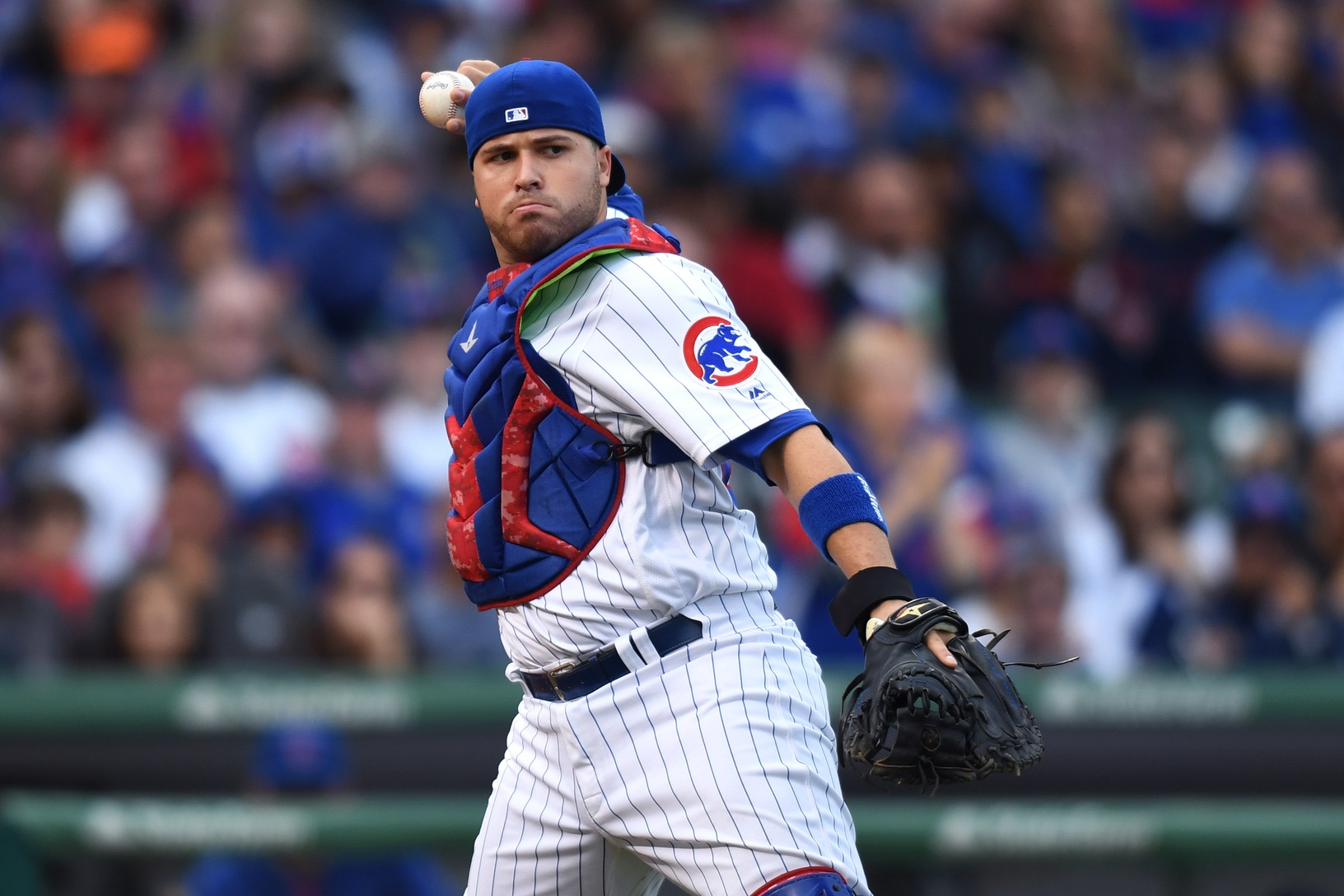There’s a little bit of a buzz recently surrounding the Chicago Cubs’ catcher position, courtesy of Willson Contreras’ mouth. The Cubs’ starting backstop, who is heading into his second full season as the starter, declared his intention of surpassing the likes of Yadier Molina and Buster Posey and serve as the game’s top catcher. Good on him for that. He definitely has the skill set to do just that, if he hasn’t already. Our concern here, though, isn’t the no. 1 catcher on the North Side, it’s the no. 2.
Or, perhaps, the lack thereof.
As things stand right now, the Cubs look prepared to roll with Victor Caratini as their backup catcher in the 2018 season. Of course, that could change depending on the performance of Chris Gimenez throughout the spring (as well as a potential Yu Darvish signing), but as of right now, he’s on a minor league deal, meaning Caratini looks poised to be the guy. There are a lot of things to like about Caratini, but many of those come on the offensive side. Some have voiced concern over a lack of defensive depth at the position, with the team passing up on reuniting with the likes of Rene Rivera and Alex Avila.
But Caratini does present some upside with the bat. His offense has vastly improved over the course of his time in the minor leagues, with a number of statistics showing a gradual increase over the last few years. The 2017 season featured a .319 TAv at the Triple-A level, as well as a 142 wRC+. He also posted an ISO of .216, while reaching base at a .393 clip across 326 plate appearances. He doesn’t possess a ton of raw power, but he’s a solid gap hitter who has the ability to take a walk and limit his strikeouts, although neither figure will stand out a ton. His 10 homers in Iowa were a career mark, so he’s primarily thought of as a gap guy for now, but there’s the potential for more power at some point down the line. He may not have an All-Star upside with the stick, but there’s some upside there nonetheless.
Caratini’s defense is where the questions start. Some of his issues are similar to that Contreras fought off during his rise up the Cubs’ minor league ranks. While it’s still a work in progress, Contreras has shown significant improvement behind the dish. Caratini has a long way to go to demonstrate such improvement, but here’s a look at his defense to this point. The following represents Contreras and Caratini in regard to specific catching metrics, in 2017:
| Framing Runs | CSAA | EPAA | SRAA | TRAA | FRAA | |
|---|---|---|---|---|---|---|
| Contreras | -6.3 | -0.007 | -0.001 | 0.022 | 0.009 | -3.0 |
| Caratini (AAA) | -3.7 | -0.006 | 0.000 | -0.002 | 0.001 | -3.6 |
Caratini spent such a small amount of time actually catching at the big league level, that examining his metrics there in comparison to Contreras’ wouldn’t have made sense. As illustrated above, there are some similarities on the framing side, but Contreras just about takes it all in a landslide with his arm, which is perhaps his best asset. The important thing to note here with Contreras is that he showed improvement in basically every single regard here. Caratini still has some development to go on the defensive side, and that’s where the concerns emerge. He was either below average, or barely average on the framing side and the throwing side behind the dish.
Ideally, a backup catcher provides stellar defense with some offensive upside. David Ross and Rene Rivera were ideal backups in Chicago because they provided excellent defense and occasional pop behind Contreras, who has the potential to become the total package. While both Contreras and Caratini feature questions about their receiving ability behind the plate, Contreras has the arm to somewhat compensate for any shortcomings. He’s also come a long way on the blocking side, and continues to demonstrate improvement. With that in mind, as well as his offensive upside, he’s obviously going to draw a massive amount of the starts behind the plate for the Cubs.
As such, you’d like a no. 2 catcher who brings the defensive upside. In spot starts, you want the guy who’s going to get the extra strikes. Hence, the Chris Gimenez signing. One of the better backups still available, he brings good receiving skills and a bit of pop (.249 TAv across 225 plate appearances). Caratini doesn’t necessarily bring that skill set. Could that be problematic? Potentially.
Of course, there’s the possibility that Caratini has really worked at his craft over the course of the offseason and could make some strides as a defensive catcher. More likely, given what you ideally look for in a no. 2, it makes far more sense for him to begin the year with Iowa and work on honing those receiving skills to develop him into a far more enticing backup. He’s going to get some innings at the big league level, especially as an additional bat in some situations, but ultimately the Cubs likely brought Gimenez in for a reason.
It’s important to keep in mind that we saw the Cubs gradually increase their catching depth throughout the year last year, with additions like Avila and Rivera. Could we see a similar situation? If not, there are likely worse trios throughout baseball than one that starts with Willson Contreras and ends with Victor Caratini and Chris Gimenez.
Lead photo courtesy Patrick Gorski—USA Today Sports
